It's all about the classical music composers and their works from the last 400 years and much more about music. Hier erfahren Sie alles über die klassischen Komponisten und ihre Meisterwerke der letzten vierhundert Jahre und vieles mehr über Klassische Musik.
Popular Posts
-
182,711 views Feb 22, 2025 #WendyKokkelkoren #Goosebumps #Ballads 00:00 - 05:00 Hallelujah 05:01 - 09:38 I Will Always Love You 09...
-
André Rieu's Son Says Goodbye After His Father's Tragic Diagnosis In this heartfelt and emotional video, we explore the touching mom...
-
by Janet Horvath , Interlude Fans of Wolfgang Amadeus Mozart will likely be aware that he was taught, shaped, and influenced by his fath...
-
Witness the "𝗛𝗮𝗿𝗺𝗼𝗻𝗶𝗲𝘀 𝗼𝗳 𝗛𝗲𝗿𝗶𝘁𝗮𝗴𝗲: 𝗔 𝗦𝘆𝗺𝗽𝗵𝗼𝗻𝘆 𝗼𝗳 𝗣𝗵𝗶𝗹𝗶𝗽𝗽𝗶𝗻𝗲 𝗖𝗼𝗹𝗼𝗻𝗶𝗮𝗹 𝗠𝘂𝘀𝗶𝗰...
-
Born in Sonzowka-Jekaterinoslaw/Russia on April 23, 1891, Serge Prokofieff passed away on March 5, 1953. His father was an estate trustee...
-
New music of such variety, imagination and originality, there is something here for everyone Caroline Shaw What were you doing when you were...
-
By Georg Predota, Interlude In the 1840s, the Parisian instrument builder Adolphe Sax provided a welcome addition to the family of woodw...
-
Wolfgang Amadeus Mozart (his complete name was Joannes Chrysostomus Wolfgangus Theophilus; Theophilus became Amadeus later) was born o...
-
International performer Michael Bublé together with the Megastar deliver a breathtaking rendition of Frank Sinatra’s timeless pop song ‘The ...
-
193,674 views Premiered Dec 15, 2024 ITALY The Best of Vivaldi: Timeless Classical Masterpieces 🎻 🎼 Dive into the timeless world of cl...
Total Pageviews
Wednesday, April 10, 2024
Schumann: Klavierkonzert ∙ hr-Sinfonieorchester ∙ Khatia Buniatishvili ∙...
Luigi Cherubini: "Requiem in do minore"
What ‘Miss Saigon’ songs are on your playlist?
Sun and Moon is a duet between Chris and Kim, which reveals the stark contrast between the star-crossed lovers, race- and social status-wise, but love wins. Photo courtesy of GMG Productions
Jerry Donato - The Philippine Star
MANILA, Philippines — Aside from the universal themes embedded in the narrative and recognizable characters, musicals are a hit because of their well-crafted songs. They give the audience a sneak peek at characters’ aspirations, intentions, and personalities — and can be seen as devices that make the storytelling unfold and move.
These songs leave a lasting impression on the audience and make them experience Last Song Syndrome (LSS). They usually become part of their everyday playlists.
An example of such a list may comprise the following tunes from musicals: Bring Him Home (by Jean Valjean), I Dreamed a Dream (Fantine), and On My Own (Eponine) from “Les Misérables;” Memory (Grizabella) from “Cats;” I Know Him So Well (Florence and Svetlana) from “Chess;” Don’t Cry for Me Argentina (Eva Peron) from “Evita;” Maria (Tony), Tonight (Tony and Maria) and Somewhere from “West Side Story;” What I Did For Love (Diana and the company) from “A Chorus Line;” Loving You (Fosca) from “Passion;” and Only He-Only You (Pearl and Rusty) and Starlight Express (Rusty) from “Starlight Express.”
Songs, definitely, from “Miss Saigon,” which is now playing at The Theatre at Solaire until May 12, will make it to the list.
Its latest Manila edition features Abigail Adriano and Nigel Huckle as the Vietnamese young woman Kim and the American G.I. Chris, respectively, with Seann Miley Moore as the French-Vietnamese bar owner The Engineer and Laurence Mossman as Kim’s cousin Thuy.
Kiara Dario, Lewis Francis, and Sarah Morrison take on the roles of bar girl Gigi, Chris’ best friend John, and Chris’ wife Ellen.
If one is an avid follower of the Alain Boublil, Claude-Michel Schonberg, and Cameron Mackintosh musical, one knows each musical number from Act 1 to Act 2 — and from Saigon-Ho Chi Minh City to Atlanta-Bangkok by heart.
Yes, we love them all, but what could a Top 6 list of “Miss Saigon” songs look like to someone who is enamored by the thoughts of “love knows no bounds,” selfless love, and living a new life.
First on the list is Sun and Moon, a duet between Chris and Kim. The lyrics reveal the stark contrast between star-crossed lovers in terms of cultural background, race, and social status, but love wins. It comes in unexpected places and situations, like being amidst of war.
Kim sets the tone by singing, “You are sunlight and I moon/ Joined by the gods of fortune/ Midnight and high noon/ Sharing the sky/ We have been blessed, you and I.”
For his part, Chris shares a piece of his mind saying, “You are here like a mystery/ I’m from a world that’s so different/ From all that you are/ How in the light of one night/ Did we come so far?”
Before he has come to such a realization, Chris seems to have grappled with the thought of loving Kim in Why God Why? It’s a solo musical number that captures the beauty of soliloquy in any dramatic presentation in which a character is attuned to his or her emotions and thoughts.
What seals the love Chris and Kim have for each other and the decision for them to move forward, despite the challenging plight they are in, is told in The Last Night of the World. They are hopeful that tomorrow will bring them change, like as he puts it, “On the other side of the earth/ There’s a place where life still has worth/ I will take you.”
Then, she reciprocates it with utter happiness in her voice, “I’ll go with you.”
The Movie in My Mind features Kim and Gigi with fellow bar girls, Dominique, Fifi, Yvonne, Mimi, and Yvette, who wish to flee their current plight.
To borrow the words of Kim, one could say that the “gods of fortune” have played significantly in their meeting and eventual romance, but maybe the gods have other plans for the couple to learn what love is.
Three years have passed (from 1975 to 1978), and Kim remains faithful to Chris, who is unaware that he and she have a son. With the help of John, Chris will meet Tam and Kim. The song, I’d Give My Life for You, depicts Kim’s evolving perspective on love, from the romantic to the selfless one, brought about by motherhood and parenthood.
She may have failed in her personal relationship, but she would love to succeed in securing Tam’s future.
“I’ll give you a million things I’ll never own/ I’ll give you a world to conquer when you’re grown,” sings Kim, and firmly assures her son with this line: “As long as you can have your chance, I swear I’d give my life for you.”
Aside from the interracial love story, “Miss Saigon” may be viewed as a tale about dreaming and fulfilling one’s aspirations, like enjoying a cheerful life or making it big somewhere. Regardless of the characters’ contexts, The Movie in My Mind and The American Dream speak of it, and they take the last two spots on the list.
These musical numbers are great and welcome additions to one’s playlist, but watching actors act and sing them on stage live promises an experience like no other.
Sunday, April 7, 2024
Josef Strauss: Ardent Love (Brennende Liebe) / Polka mazurka op. 129 (1863)
Saturday, April 6, 2024
Christina Perri - A Thousand Years [Official Music Video]
Save The Last Dance For Me by Emmylou Harris (with lyrics)
Last 'Switch' for PPO's 39th concert season
BY MANILA BULLETIN ENTERTAINMENT
AT A GLANCE
For its finale concert, the resident orchestra of the Cultural Center of the Philippines will feature violinist Diomedes Saraza Jr. as its guest soloist.

The Philippine Philharmonic Orchestra, the country’s primary orchestra, will take its last ‘Switch’ for its 39th concert season on April 19, 7:30 pm, at the Samsung Performing Arts Theater in Circuit Makati.
For its finale concert, the resident orchestra of the Cultural Center of the Philippines will feature violinist Diomedes Saraza Jr. as its guest soloist.
Saraza Jr. is an active concert violinist, chamber musician, and avid educator. The former Manila Symphony Orchestra’s concertmaster, Saraza is a well-established musical artist that has taken part in many international solo performances with different orchestras such as the Mannes Orchestra, New York Symphonic Arts Ensemble, the Sichuan Philharmonic Orchestra to name a few. His extensive solo and chamber performances include prestigious venues that span from Philippines’ Cultural Center of the Philippines, New York’s Avery Fisher Hall, Alice Tully Hall, Carnegie Hall, to Russia’s Tchaikovsky’s Concert Hall among others.
For its final concert, PPO music director and principal conductor Maestro Grzegorz Nowak will take the baton, leading the national orchestra in a night of Fete Francaise. The concert program includes: National Artist Lucresia Kasilag's Violin Concerto No. 1, Camille Saint-Saëns’ Introduction & Rondo Capriccioso, Op. 28, and Franz Schubert’s Symphony No. 5.
An instrumental in developing Philippine music and culture, the National Artist for Music was recognized for including indigenous Filipino instruments into orchestral productions. She has written more than 350 musical compositions that range from folksongs to opera to orchestral pieces. She was the founding mother of the Bayanihan Folk Arts Center for research and theatrical presentations and actively involved herself with the Bayanihan Philippine Dance Company.

Camille Saint-Saëns was a French composer, organist, conductor and pianist of the Romantic era. A child prodigy, he was already giving public concerts as a pianist and organist at a young age. One of his best-known works is the Introduction & Rondo Capriccioso, op. 28. composed in 1863, it was dedicated to Pablo de Sarasate, a Spanish virtuoso violinist, who frequently programmed it in his concert engagements, thus making it popular enough that other French composers made arrangements of it.
Completing the concert finale’s program is Schubert’s Symphony No. 5, a classic piece which is said to pay homage to masters Mozart and Haydn. Schubert deeply admired Mozart. His composition is frequently said to resemble the prolific and influential composer.
Ranked among the greatest composers in the history of Western classical music, Schubert and his work continues to be admired and widely performed. He was a composer during the late Classical and early Romantic eras. He has composed symphonies, masses, and piano works and is best remembered for his “lieder."
Tickets to PPO Concert VIII: Fete Francaise are priced at Php3,000 (Orchestra Center), Php2,000 (Orchestra Side), Php2,500 (Loge Center), Php1,500 (Loge Side), and Php800 (Balcony 1).
The PPO concert season is made possible with partners SSI Group, Inc., TBWA\SMP, Ascott Bonifacio Global City, and Lyf Malate Manila.
For more information, visit the CCP (www.culturalcenter.gov.ph) and follow the official CCP social media accounts on Facebook, X, and Instagram for the latest updates.
Friday, April 5, 2024
I Wanna Grow Old With You - Westlife
Charles Villiers Stanford - Piano Concerto No.2 in C-minor, Op.126 (1911)
Charles Villiers Stanford
by Georg Predota, Interlude
As a composer, Charles Villiers Stanford (1852-1924) might not be a household name, but he is remembered as a teacher of several generations of British composers at the RCM and Cambridge University. However, there is a clear disconnect between how he was celebrated in his day, and how posterity has decided to look at him.
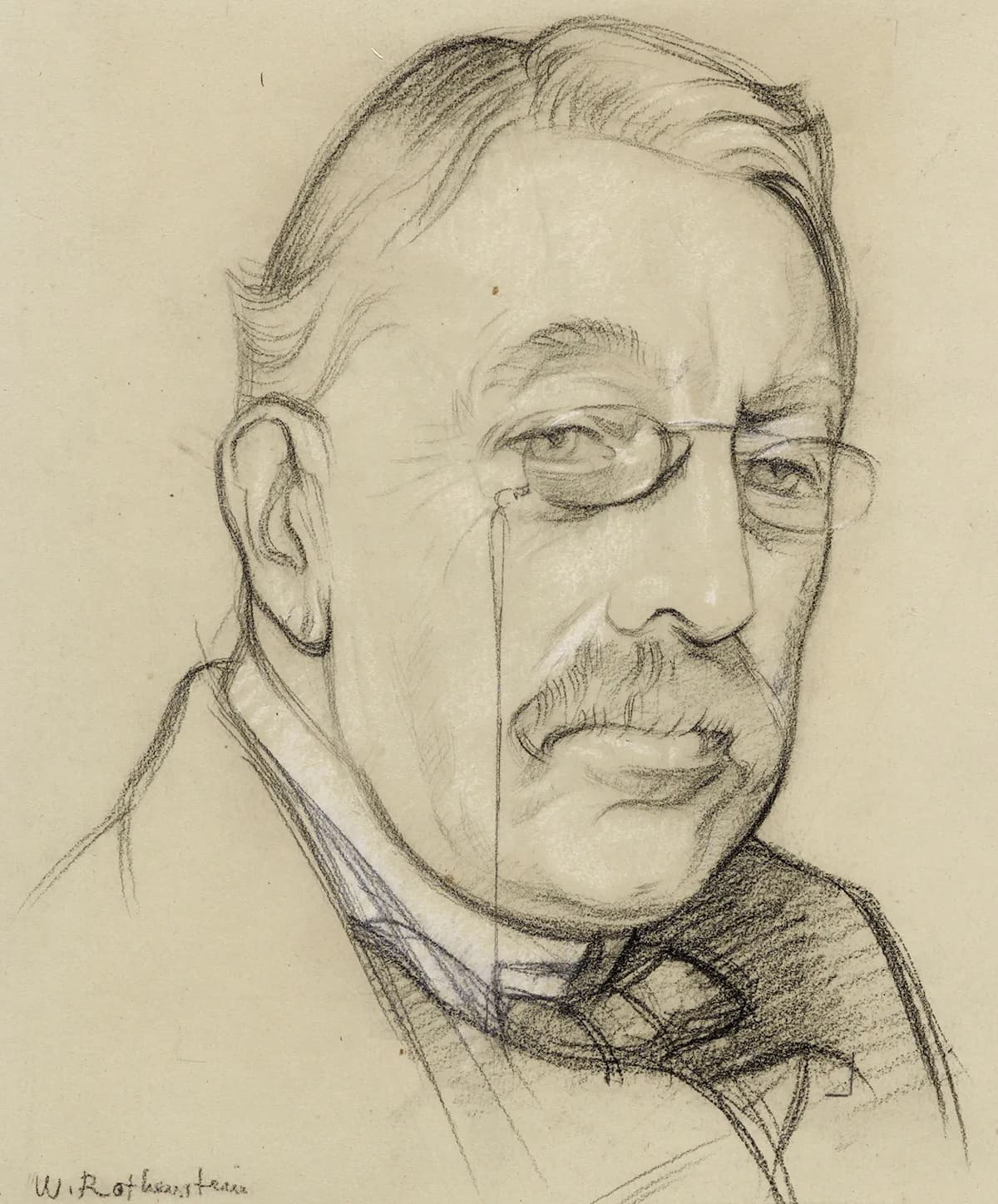
Charles Villiers Stanford
Villiers Stanford was highly lauded during his lifetime as an exceptional composer of large works for chorus and orchestra, and he received a knighthood on the occasion of King Edward VII’s coronation. Posterity, however, has been less kind. The musicologist Robert Stove writes, “Sir Charles Villiers Stanford has not so much been neglected, but posterity has derived malicious satisfaction from ostentatiously yawing in his face.”
Centenary of Death
Villiers Stanford died 100 years ago, on 29 March 1924, and he untiringly campaigned for a national opera, as he saw “opera as a vital catalyst in Britain’s musical renaissance.” He was a mover and a shaker, but his music became associated with Victorian fustiness, worthy if ultimately inconsequential.
As Ralph Vaughan Williams wrote, “in Stanford’s music the sense of style, the sense of beauty, the feeling of a great tradition is never absent. His music is in the best sense of the word Victorian, that is to say, it is the musical counterpart of the art of Tennyson, Watts and Matthew Arnold.”
Critical Assessment
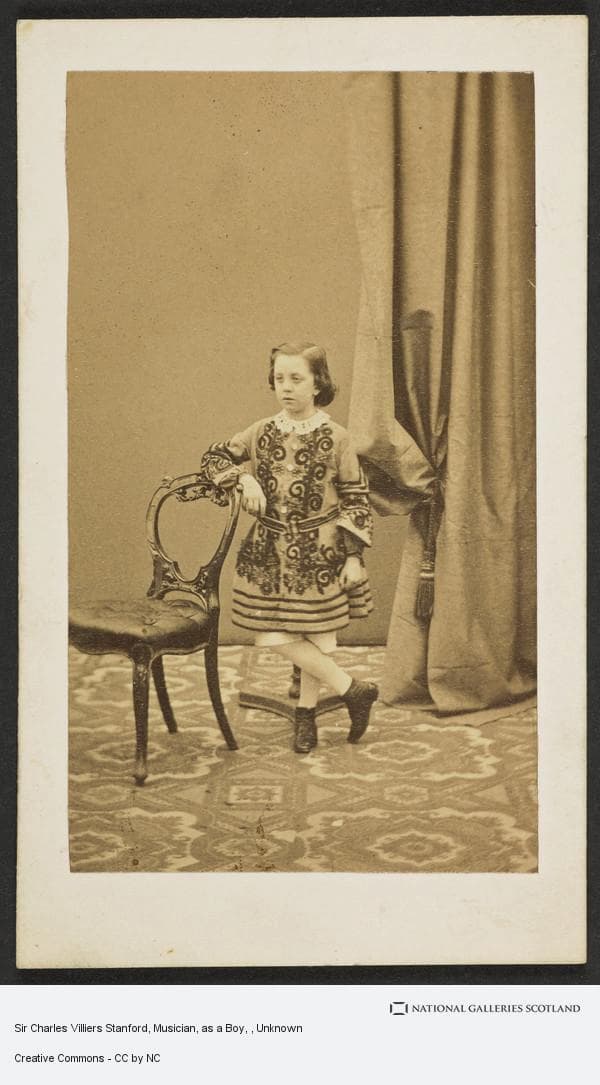
Charles Villiers Stanford as a boy
Villiers Stanford was a busy man. He composed roughly 200 works, including seven symphonies, about 40 choral works, nine operas, 11 concertos, and 28 chamber works. And this is in addition to songs, piano pieces, incidental music, and organ works. Stanford’s technical competence was never in doubt, as the composer Edgar Bainton wrote, “Whatever opinions might be held upon Stanford’s music, and they are many and various, it is always recognised that he was a master of means.”
It’s been suggested by countless critics that Stanford’s music lacked passion. In his operas, critics found music that ought to convey love and romance but fails to do so. His church music is “a thoroughly satisfying artistic experience, but one that is lacking in deeply felt religious impulse. And while Stanford had a real gift for melody often infused with the contours of Irish folk music, he never emulated comic operas but produced oratorios that “only occasionally matched worthiness with power and profundity.”
Beginnings
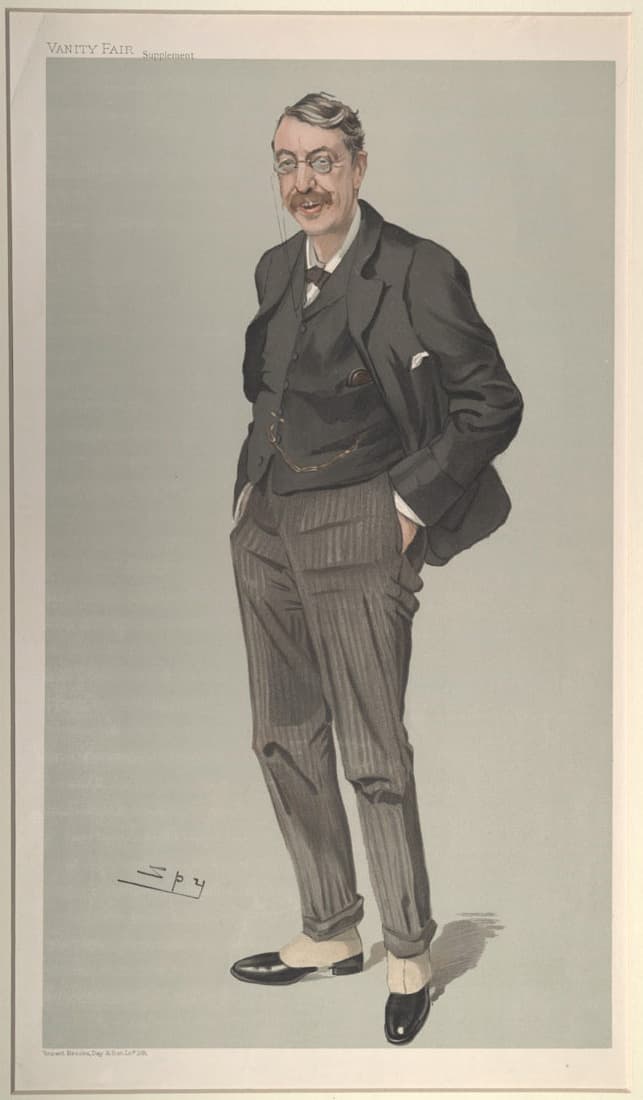
Charles Villiers Stanford
Born on 30 September 1852 in Dublin, Charles Villiers Stanford was the only child of the city’s most eminent lawyer. He grew up in a highly stimulating cultural and intellectual environment, and his childhood home was the meeting place of countless amateur and professional musicians. In fact, his father was a capable cellist and singer, and his mother an able pianist, with various celebrities such as Joseph Joachim visiting the home.
Stanford showed early musical promise, and he took violin, piano, and organ lessons. His teachers were of the highest calibre, including former students of Ignaz Moscheles. And he clearly had plenty of talent. He gave his first piano recital for an invited audience at the age of seven, presenting works by Beethoven, Handel, Mendelssohn, Moscheles, Mozart, and Bach. Long before the age of twelve, “he could play through all fifty-two Mazurkas by Chopin on sight,” and his earliest composition attempts emerged at the age of eight.
Cambridge and Leipzig
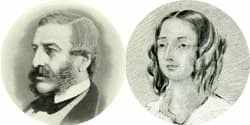
Charles Villiers Stanford’s parents
Not entirely unexpected, Stanford’s father wanted his son to enter the legal profession. Finally, in 1870, Stanford was able to gain the consent of his parents to pursue a career in music. He won an organ scholarship at Queens’ College, Cambridge, and immersed himself in various musical activities. He composed prodigiously and was elected assistant conductor to the Cambridge University Musical Society.
On the recommendation of Sir William Sterndale Bennett, Stanford spent the last six months of both 1874 and 1875 in Leipzig. He studied piano with Robert Papperitz and composition with Carl Reinecke. As Stanford reported, “Of all the dry musicians I have ever known, Reinecke was the most desiccated. He had not a good word for any contemporary composer, he loathed Wagner, sneered at Brahms, and had no enthusiasm of any sort.” To round off his continental study tour, Stanford spent some time in Berlin, working with Friedrich Kiel. “I learned more from him in three months,” he writes, “than from all the others in three years.”
Back in Cambridge
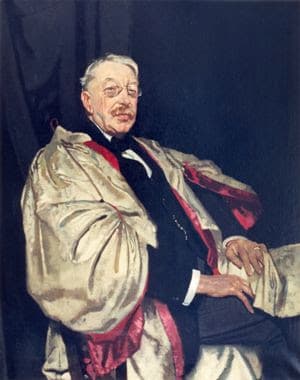
Stanford returned to Cambridge in January 1877, and he quickly became known as a conductor and composer. For one, he conducted the first British performance of Brahms’s First Symphony, and he completed his own First Symphony and the oratorio The Resurrection. He quickly followed up with his Second Symphony and the Piano Quintet, and as the organist at Trinity, he composed “some highly distinctive church music.”
At the age of 35, Stanford was appointed professor of music at Cambridge, with his students including Coleridge-Taylor, Holst, Vaughan Williams, and Ireland. By all accounts, he was not an easy teacher. He only taught in one-on-one tutorials, and “when students went into the teacher’s room, they came out badly damaged.” Apparently, Stanford’s teaching did not follow a prescribed plan or method. “His criticism,” as reported by a former student, “consisted for the most part of “I like it, my boy,” or “It’s damned ugly, my boy” (the latter in most cases).”
Royal College of Music
Stanford joined the staff of the newly inaugurated RCM as a professor of composition and conductor of the orchestra in 1883. He exerted considerable influence on a long list of students, and he instigated an opera class with an annual production. A scholar writes, “Stanford’s enthusiasm for opera is demonstrated by his lifelong commitment to a genre in which he enjoyed varying success.”
Stanford also took on the conductorship of the Bach Choir, the Leeds Philharmonic Society, and the Leeds Triennial Festival. He received honorary degrees from Oxford, Cambridge, Durham, and Leeds, and was knighted in 1902. Stanford continued to be active as a composer as well, but his music was gradually eclipsed by the young Edward Elgar. As Stanford was known as a hot-tempered and quarrelsome man, confrontations quickly ensued with Stanford writing, “Elgar, cut off from his contemporaries by his religion and his want of regular academic training, was lucky enough to enter the field and find the preliminary ploughing done.”
Thoughts on Music and Composers
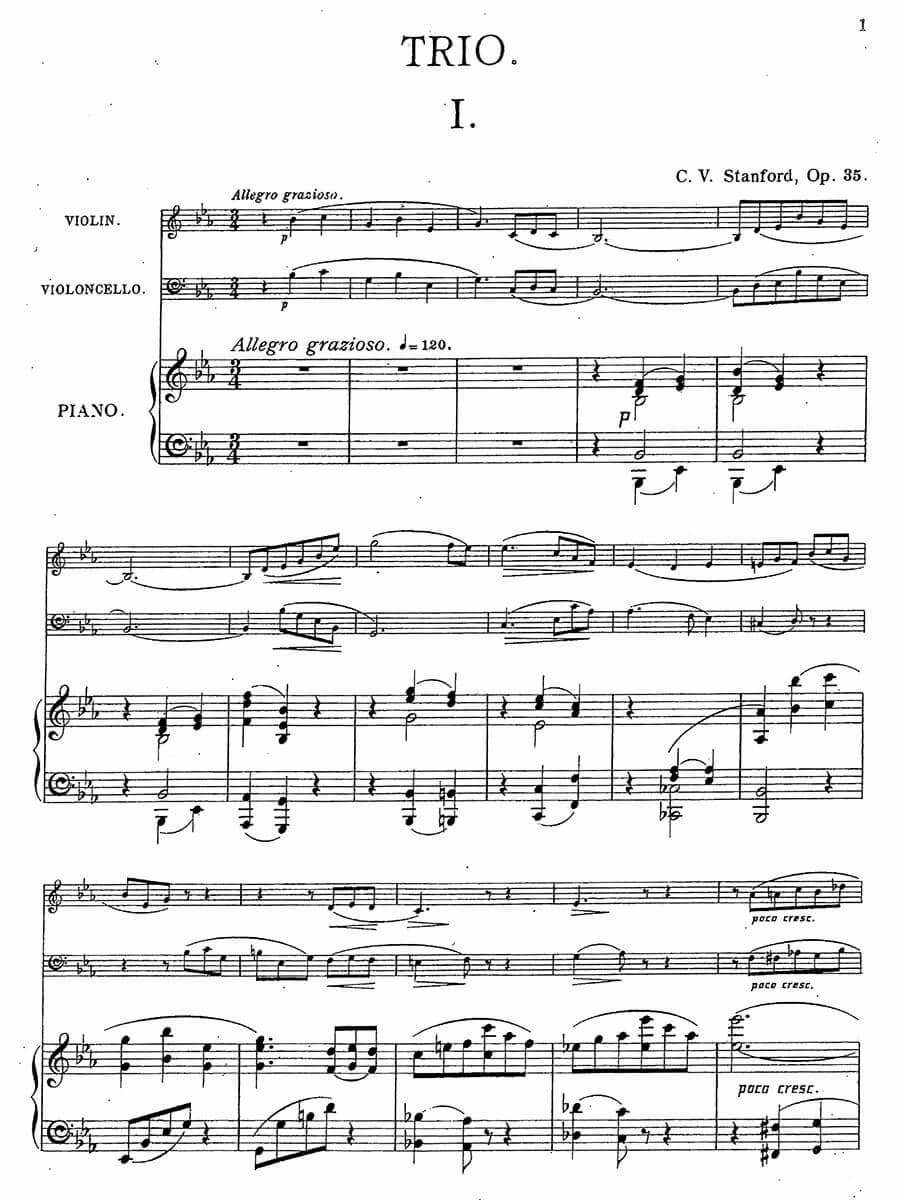
Charles Villiers Stanford’s Piano Trio
In his writings on music, Stanford frequently uses visual metaphors and references to painting and sculpture. His ideas on the subject can be reduced to simple statements. “A piece of music can survive bad texture and instrumentation, but never bad melody or design.” As he famously wrote, “Colour, the god of modern music, is in itself the inferior of rhythmic and melodic invention, although it will always remain one of its most important servants. Fine clothes will not make a bad figure good.”
In the musical culture war of the period, Stanford always sided with Brahms and against the modernists, although he had a great admiration for Wagner. He counted Berlioz and Liszt as lesser practitioners of the musical art, and he most bitterly objected to the music of Richard Strauss. Concerning Debussy and the new French School that emerged in the 1890’s, Stanford was deeply ambivalent.
Stanford was tormented by musical and aesthetic dichotomies at the end of his life. Always wrestling with his status in relation to Irish and English culture, he experienced what Yeats described as “my hatred tortures me with love, my love tortures me with hate.”




